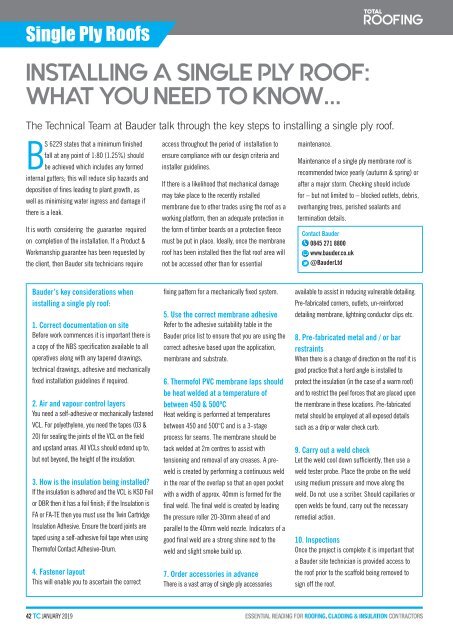January 2019
Create successful ePaper yourself
Turn your PDF publications into a flip-book with our unique Google optimized e-Paper software.
Single Ply Roofs<br />
INSTALLING A SINGLE PLY ROOF:<br />
WHAT YOU NEED TO KNOW...<br />
The Technical Team at Bauder talk through the key steps to installing a single ply roof.<br />
BS 6229 states that a minimum finished<br />
fall at any point of 1:80 (1.25%) should<br />
be achieved which includes any formed<br />
internal gutters; this will reduce slip hazards and<br />
deposition of fines leading to plant growth, as<br />
well as minimising water ingress and damage if<br />
there is a leak.<br />
It is worth considering the guarantee required<br />
on completion of the installation. If a Product &<br />
Workmanship guarantee has been requested by<br />
the client, then Bauder site technicians require<br />
access throughout the period of installation to<br />
ensure compliance with our design criteria and<br />
installer guidelines.<br />
If there is a likelihood that mechanical damage<br />
may take place to the recently installed<br />
membrane due to other trades using the roof as a<br />
working platform, then an adequate protection in<br />
the form of timber boards on a protection fleece<br />
must be put in place. Ideally, once the membrane<br />
roof has been installed then the flat roof area will<br />
not be accessed other than for essential<br />
maintenance.<br />
Maintenance of a single ply membrane roof is<br />
recommended twice yearly (autumn & spring) or<br />
after a major storm. Checking should include<br />
for – but not limited to – blocked outlets, debris,<br />
overhanging trees, perished sealants and<br />
termination details.<br />
Contact Bauder<br />
0845 271 8800<br />
www.bauder.co.uk<br />
@BauderLtd<br />
Bauder’s key considerations when<br />
installing a single ply roof:<br />
1. Correct documentation on site<br />
Before work commences it is important there is<br />
a copy of the NBS specification available to all<br />
operatives along with any tapered drawings,<br />
technical drawings, adhesive and mechanically<br />
fixed installation guidelines if required.<br />
2. Air and vapour control layers<br />
You need a self-adhesive or mechanically fastened<br />
VCL. For polyethylene, you need the tapes (03 &<br />
20) for sealing the joints of the VCL on the field<br />
and upstand areas. All VCLs should extend up to,<br />
but not beyond, the height of the insulation.<br />
3. How is the insulation being installed?<br />
If the insulation is adhered and the VCL is KSD Foil<br />
or DBR then it has a foil finish; if the Insulation is<br />
FA or FA-TE then you must use the Twin Cartridge<br />
Insulation Adhesive. Ensure the board joints are<br />
taped using a self-adhesive foil tape when using<br />
Thermofol Contact Adhesive-Drum.<br />
4. Fastener layout<br />
This will enable you to ascertain the correct<br />
fixing pattern for a mechanically fixed system.<br />
5. Use the correct membrane adhesive<br />
Refer to the adhesive suitability table in the<br />
Bauder price list to ensure that you are using the<br />
correct adhesive based upon the application,<br />
membrane and substrate.<br />
6. Thermofol PVC membrane laps should<br />
be heat welded at a temperature of<br />
between 450 & 500ºC<br />
Heat welding is performed at temperatures<br />
between 450 and 500°C and is a 3-stage<br />
process for seams. The membrane should be<br />
tack welded at 2m centres to assist with<br />
tensioning and removal of any creases. A preweld<br />
is created by performing a continuous weld<br />
in the rear of the overlap so that an open pocket<br />
with a width of approx. 40mm is formed for the<br />
final weld. The final weld is created by leading<br />
the pressure roller 20-30mm ahead of and<br />
parallel to the 40mm weld nozzle. Indicators of a<br />
good final weld are a strong shine next to the<br />
weld and slight smoke build up.<br />
7. Order accessories in advance<br />
There is a vast array of single ply accessories<br />
available to assist in reducing vulnerable detailing.<br />
Pre-fabricated corners, outlets, un-reinforced<br />
detailing membrane, lightning conductor clips etc.<br />
8. Pre-fabricated metal and / or bar<br />
restraints<br />
When there is a change of direction on the roof it is<br />
good practice that a hard angle is installed to<br />
protect the insulation (in the case of a warm roof)<br />
and to restrict the peel forces that are placed upon<br />
the membrane in these locations. Pre-fabricated<br />
metal should be employed at all exposed details<br />
such as a drip or water check curb.<br />
9. Carry out a weld check<br />
Let the weld cool down sufficiently, then use a<br />
weld tester probe. Place the probe on the weld<br />
using medium pressure and move along the<br />
weld. Do not use a scriber. Should capillaries or<br />
open welds be found, carry out the necessary<br />
remedial action.<br />
10. Inspections<br />
Once the project is complete it is important that<br />
a Bauder site technician is provided access to<br />
the roof prior to the scaffold being removed to<br />
sign off the roof.<br />
42 TC JANUARY <strong>2019</strong>

















